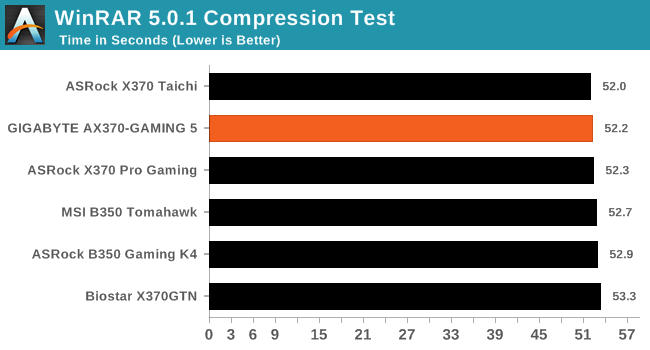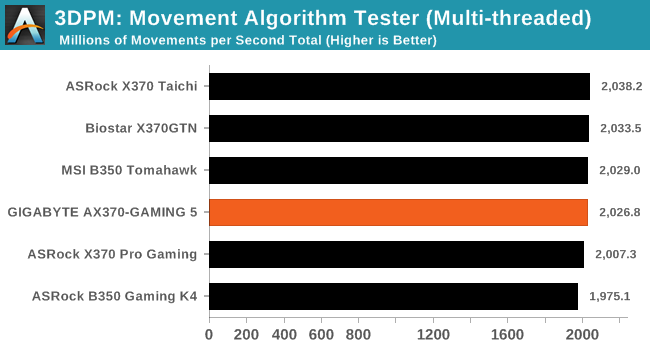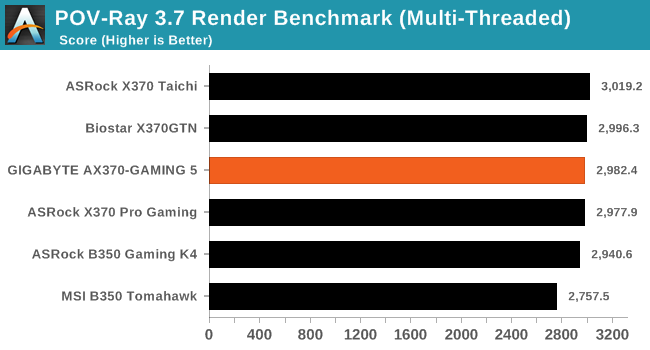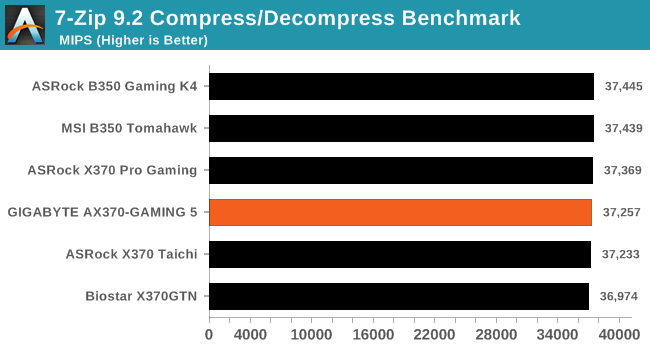The GIGABYTE Aorus AX370-Gaming 5 Review: Dual Audio Codecs
by Gavin Bonshor on November 14, 2017 12:30 PM ESTCPU Performance, Short Form
For our motherboard reviews, we use our short form testing method. These tests usually focus on if a motherboard is using MultiCore Turbo (the feature used to have maximum turbo on at all times, giving a frequency advantage), or if there are slight gains to be had from tweaking the firmware. We put the memory settings at the CPU manufacturers suggested frequency, making it very easy to see which motherboards have MCT enabled by default.
Video Conversion – Handbrake v1.0.2: link
Handbrake is a media conversion tool that was initially designed to help DVD ISOs and Video CDs into more common video formats. For HandBrake, we take two videos and convert them to x264 format in an MP4 container: a 2h20 640x266 DVD rip and a 10min double UHD 3840x4320 animation short. We also take the third video and transcode it to HEVC. Results are given in terms of the frames per second processed, and HandBrake uses as many threads as possible.



Compression – WinRAR 5.4: link
Our WinRAR test from 2013 is updated to the latest version of WinRAR at the start of 2017. We compress a set of 2867 files across 320 folders totaling 1.52 GB in size – 95% of these files are small typical website files, and the rest (90% of the size) are small 30 second 720p videos.

Point Calculations – 3D Movement Algorithm Test v2.1: link
3DPM is a self-penned benchmark, taking basic 3D movement algorithms used in Brownian Motion simulations and testing them for speed. High floating point performance, MHz and IPC wins in the single thread version, whereas the multithread version has to handle the threads and loves more cores. For a brief explanation of the platform agnostic coding behind this benchmark, see my forum post here. We are using the latest version of 3DPM, which has a significant number of tweaks over the original version to avoid issues with cache management and speeding up some of the algorithms.

Rendering – POV-Ray 3.7.1b4: link
The Persistence of Vision Ray Tracer, or POV-Ray, is a freeware package for as the name suggests, ray tracing. It is a pure renderer, rather than modeling software, but the latest beta version contains a handy benchmark for stressing all processing threads on a platform. We have been using this test in motherboard reviews to test memory stability at various CPU speeds to good effect – if it passes the test, the IMC in the CPU is stable for a given CPU speed. As a CPU test, it runs for approximately 2-3 minutes on high end platforms.

Synthetic – 7-Zip 9.2: link
As an open source compression tool, 7-Zip is a popular tool for making sets of files easier to handle and transfer. The software offers up its own benchmark, to which we report the result.











34 Comments
View All Comments
khanmein - Tuesday, November 14, 2017 - link
Why not using Handrake v1.0.7?PeachNCream - Tuesday, November 14, 2017 - link
That's probably so benchmark results are can be compared with previous reviews.IGTrading - Thursday, November 16, 2017 - link
Thank you for the good review.I also think there should be some USB transfer tests and LAN NIC tests as well.
Nothing too complicated, just large file transfer speeds, photo files and a set of small diverse files.
And maybe we should throw a comparable Intel setup in there, just to see how how the chipsets compare while handling the USB and LAN transfers, BOOT speeds, etc.
ayqazi - Tuesday, November 14, 2017 - link
I can't actually understand why you would have 2 audio codecs... or perhaps this is a case of "if you have to ask what it's for, you don't need it"HollyDOL - Tuesday, November 14, 2017 - link
The use cases are super rare, but still might come in handy. I use the machine as a terminal for two users (with added Aster software layer), each has own audio, so it's possible each user has complete experience, being able to use speakers or headset etc.Lord of the Bored - Tuesday, November 14, 2017 - link
Honestly, for an admittedly super-rare use case, I would just tell people "install a sound card if you want a second set of DACs". God knows there's enough slots for it.Samus - Wednesday, November 15, 2017 - link
The ridiculous thing is taking up real estate or a second Codec when one can be added via USB for $10.HollyDOL - Wednesday, November 15, 2017 - link
Actually that's exactly what I do, dedicated card plays better anyway :-)milli - Tuesday, November 14, 2017 - link
Did you read the review?One is dedicated to the back and one to the front.
If you didn't know, these audio codecs don't have the same quality output over all channels and usually the front audio quality takes a hit. Hence the dual codec arrangement.
Hixbot - Tuesday, November 14, 2017 - link
Isn't everyone these days just using digital audio output. Better to Bitstream to a quality dac, no need for on board dac, especially two of them